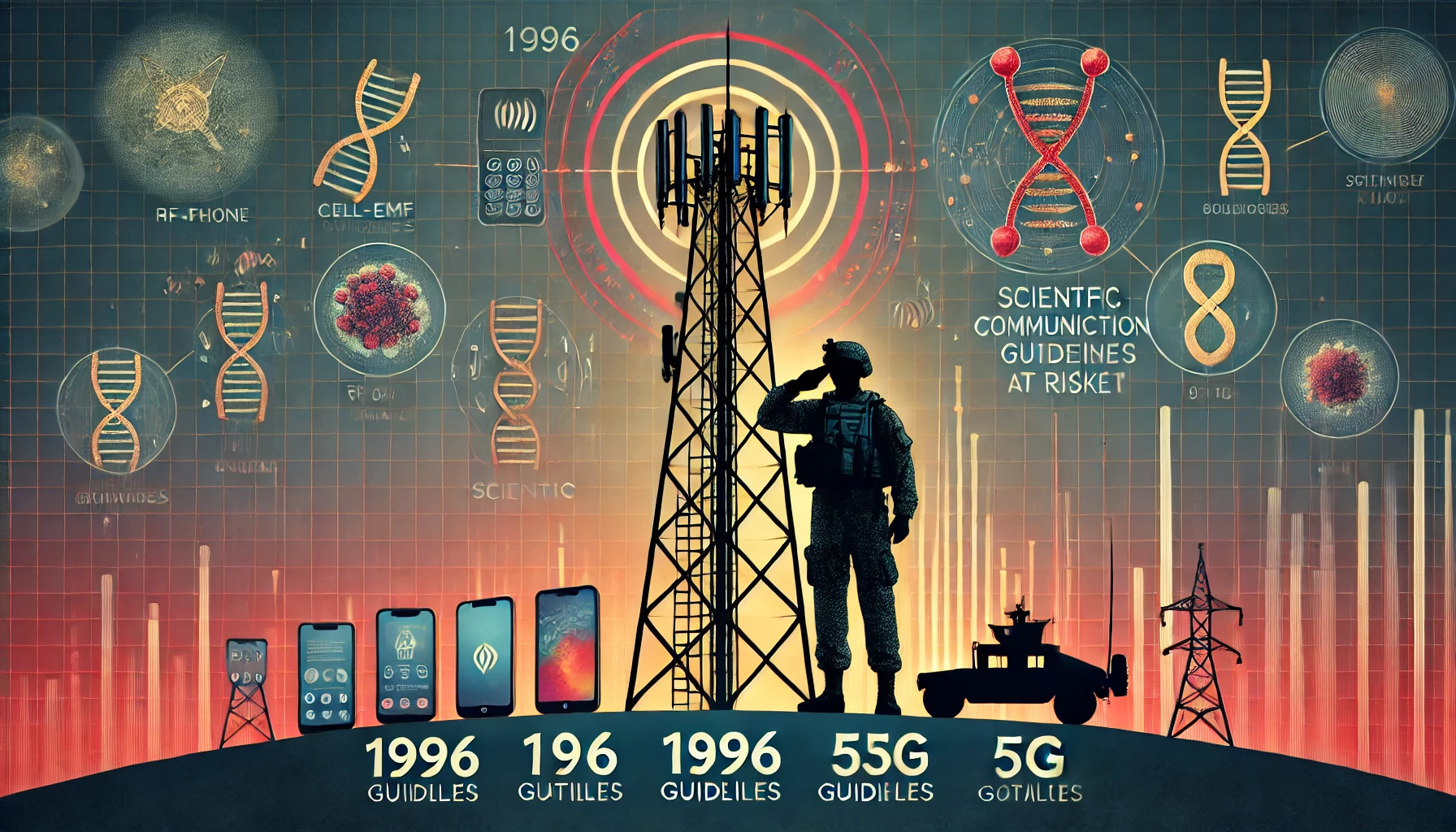Ok, this is what needs to be addressed because outdated FCC, which the FDA relies on, is used to protect our military personnel. “Few health effects are documented below safety limits. The FDA has found insufficient evidence to support a causal association between RF radiation and tumors.” – The FDA relies on the outdated guidance of the FCC. The FCC has lost a lawsuit filed by RFK Jr. that shows the FCC guideline has not been updated since 1996! Details below!
The document “Suspected Radiofrequency EMF Overexposure, 12 Jul 2024” provides a comprehensive guideline for medical providers responsible for military service members following suspected acute radiofrequency electromagnetic field overexposure.
Health Effects of RF-EMF Overexposure: The guidance document “Suspected Radiofrequency EMF Overexposure, 12 Jul 2024” outlines key points and highlights regarding the adverse health effects of RF-EMF overexposure. It emphasizes awareness, early treatment, documentation, and evaluation but continues to assert that non-cumulative effects exist and primarily attribute health impacts to bulk tissue heating—an outdated understanding given modern research that puts military personnel at risk.
Here are the key points and highlights from the document:
Key Points:
- Awareness: Medical providers must be aware of potential adverse health effects of RF-EMF overexposure.
- Early Treatment: Early evaluation and treatment are crucial for recovery.
- Common Symptoms: Sensation of warmth, pain, profuse sweating, and skin burns.
- Severe Symptoms: Life-threatening emergencies and permanent eye and visual system injuries are rare.
- Neurological Symptoms: Persistent or worsening neurological complaints require priority medical evacuation.
- Documentation: Consistent and timely documentation and reporting of RF-EMF overexposures and injuries are essential.
- Non-Cumulative Effects: Unlike ionizing radiation, health effects from RF-EMF exposures are not cumulative. (WRONG!)
Introduction:
- Safety Hazards: Acute RF-EMF overexposures pose safety hazards to service members.
- Definition of Overexposure: Exposure exceeding the Exposure Reference Level (ERL) limits may cause harmful health effects.
- Frequency Range: The guideline focuses on frequencies between 100 kHz and 300 GHz.
- Clinical Care Guidelines: Aimed at first-line medical responders and military health care providers.
Background:
- Natural and Man-Made Radiation: Electromagnetic radiation sources include natural (sun) and man-made (navigation systems, radar, etc.).
- Military Devices: Additional duty-related RF-EMF devices for military personnel.
- DoD Guidelines: Protecting personnel from electromagnetic fields as per DoD Instruction 6055.11.
Introduction: Recent developments and court rulings have brought to light the alarming reality that the guidelines followed by the FDA, based on the FCC’s standards, are dangerously outdated. These guidelines, which date back to 1996, fail to incorporate the vast body of scientific research conducted over the past decades, thereby putting military personnel at significant risk of harm from radiofrequency electromagnetic fields (RF-EMF). This blog post will explore the implications of these outdated guidelines, the proven risks of RF-EMF exposure, and the urgent need for updated standards to protect those who serve.
The Lawsuit and Outdated Guidelines: In a landmark case, it was revealed that the FCC has not updated its guidelines to reflect scientific research post-1996. This is particularly concerning given the National Toxicology Program (NTP) found clear evidence of cancer linked to RF-EMF exposure. Despite these findings, the FDA continues to follow the FCC’s outdated standards, stating there is insufficient evidence to support a causal association between RF radiation and tumors. This stance ignores the significant research pointing to risks at levels below current safety limits.
Research Findings on RF-EMF Exposure:
- National Toxicology Program (NTP) Findings: The NTP’s extensive research showed clear evidence of carcinogenic activity in rats exposed to RF-EMF, which aligns with the frequencies and exposures that humans, including military personnel, encounter.
- Ramazzini Institute Study: Complementing the NTP findings, the Ramazzini Institute study confirmed increased incidence of malignant schwannomas in rats exposed to environmental levels of RF-EMF.
- Non-Thermal Effects: A recent literature review highlights potential non-thermal molecular effects of RF-EMF on cancer cells, including altered gene expression, membrane potentials, and cellular morphology. These effects occur at levels below the current safety guidelines, suggesting that even non-thermal exposures could be harmful.
Military Personnel at Risk: Military service members are particularly vulnerable due to their exposure to high-powered RF-EMF sources, such as communication and navigation systems. The outdated guidelines do not account for modern technology’s more pervasive and intense RF-EMF exposure. Symptoms of overexposure include thermal effects like burns and non-thermal effects such as neurological symptoms, which can severely impact health and operational readiness.
Lack of Ongoing Research: One of the most concerning aspects is the halt of further research by the NTP after finding clear evidence of cancer from RF-EMF exposure. The cessation of this crucial research leaves a gap in understanding the full spectrum of risks associated with RF-EMF, perpetuating reliance on outdated guidelines.
Call to Action: It is imperative that the FDA and FCC update their guidelines to reflect current scientific understanding and protect military personnel from the proven risks of RF-EMF exposure. By acknowledging the evidence from recent studies and the limitations of the 1996 standards, we can advocate for better safety measures and further research into non-thermal effects.
Conclusion: The outdated RF-EMF exposure guidelines followed by the FDA and enforced by the FCC pose a significant risk to military personnel. The body of evidence, including findings from the NTP and the Ramazzini Institute, underscores the need for updated, science-based guidelines that account for both thermal and non-thermal effects of RF-EMF. It is crucial to prioritize the health and safety of those who serve by advocating for modernized standards and ongoing research into the potential harms of RF-EMF exposure.
Health Effects of RF-EMF Overexposure:
- Mechanism: The guidance claims that bulk tissue heating is the primary mechanism for adverse health effects at RF frequencies > 5 MHz. Wow, this is so crazy outdated!
- Penetration Depth: Higher frequencies result in more superficial injuries, while lower frequencies can cause systemic effects.
- Below Exposure Limits: The guidance claims the FDA has found insufficient evidence to support a causal association between RF radiation and tumors because it refuses to review science over the last twenty years, considering only pre-1996 research used in FCC guidance.
- Above Exposure Limits: Increasing the dose above safety limits increases the risk and severity of adverse health effects.
Signs & Symptoms:
- General Symptoms: Warmth, erythema, shocks, burns, pain, headache, nausea, visual disturbances, etc.
- Evaluation: Comprehensive medical evaluation and documentation of the incident details and symptoms.
Treatment:
- Burns: Cooling the burn, analgesia, antibiotic ointments, hydration, and monitoring.
- Hyperthermia: Temperature monitoring, fluid and electrolyte replacement, and cooling.
- Ocular Injuries: Eye injuries should be treated per current standards in coordination with an eye care provider.
- Neuropsychological Symptoms: Rule out TBI from other causes and treat additional symptoms following standard care.
Disposition:
- Flight Surgeons: Follow service-specific guidelines for aviation personnel.
- Forward Providers: Service members may return to duty if they return to baseline function within 2-4 hours. Full documentation and incident reporting are required for cases with transient or visible symptoms.
Performance Improvement Monitoring:
- Population of Interest: All patients with RF-EMF overexposures or injuries.
- Intent: Monitor performance improvement metrics and ensure comprehensive medical evaluation and documentation.
For further details, the document includes appendices with exposure reference levels, telemedicine/teleconsultation services, and information regarding off-label uses in clinical practice guidelines.
VISIT RF SAFE’S TRIBUTE SITE LIBERTYUNITES









